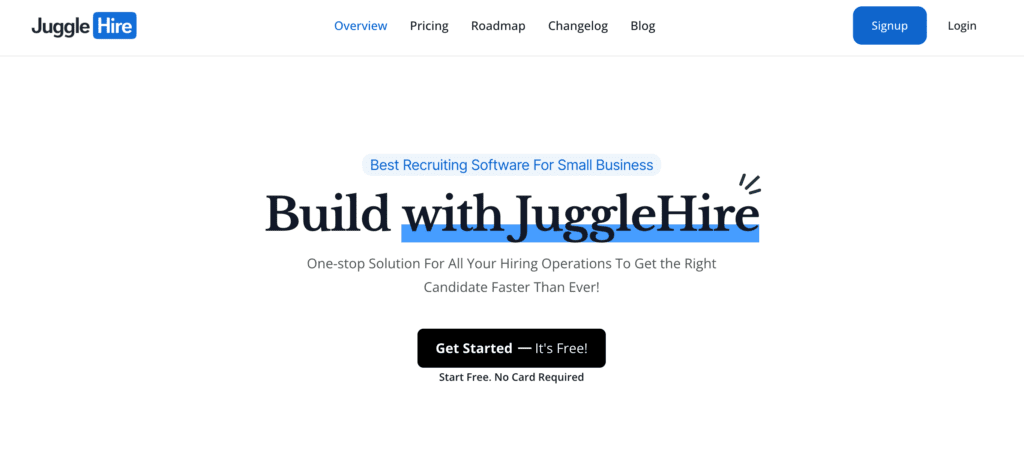Remote Hiring Tips: How To Attract, Hire and Retain Remote Employees

The surge in remote work is undeniable, but are your remote hiring processes keeping pace? This guide is your comprehensive resource, covering everything you need to know about attracting, hiring, and retaining high-quality remote employees.
According to studies, A remarkable 93% of employers plan to continue conducting job interviews remotely and a staggering 98% of employees want to work remotely. This indicates a willingness to adapt to virtual methods and signals the recognition of remote work as a sustainable option.
Remote work offers a multitude of benefits for both employees and organizations. Workers appreciate the flexibility in schedules and locations, more time with family, and the elimination of commutes. Organizations, in turn, enjoy enhanced employee retention, cost savings (including reduced office rent), heightened productivity, and access to expansive talent pools.
If you haven’t already revamped and optimized your remote hiring processes, now is the opportune moment to do so with the help of our guide on remote hiring tips.
What is Remote Hiring?
Remote hiring, also referred to as remote recruiting, involves the tech-driven process of identifying, attracting, screening, shortlisting, interviewing, and ultimately hiring candidates to fill positions within your organization.
The fundamental difference from traditional hiring and remote jobs hiring lies in the fact that the new employee will operate outside the office environment.
These individuals may choose to work from home, utilize co-working spaces, or even reside overseas. Notably, especially in the case of overseas hires, there’s a possibility that the hiring organization and the remote employee may never have a face-to-face meeting.
When You Should Hire Remotely?
When you should hire remotely depends on several factors. If your company needs to access a larger talent pool, hiring remotely is a good choice. It allows you to find the best people for the job, no matter where they live. This is especially useful for finding specialists or experts in a particular field who may not be available in your local area.
Remote hiring is also beneficial if you want to reduce office costs. Without the need for a large office space, you can save money on rent, utilities, and office supplies. This cost-saving can be significant, especially for startups or small businesses with tight budgets.
If you aim to offer a better work-life balance for your employees, remote work can be attractive. Many people appreciate the flexibility of working from home, as it can reduce commute times and allow for a more flexible schedule. This can lead to happier, more productive employees.
In cases where your business operates across different time zones, having remote employees can ensure that your company can function around the clock. It enables you to provide support and services to customers worldwide without interruption.
Finally, in situations where there’s a global crisis like a pandemic, remote hiring becomes not just beneficial but essential. It allows your business to continue operating while keeping your team safe.
10 Benefits of Remote Hiring As a Small Company

Remote hiring brings many benefits to both employers and employees. Let’s have a detailed look at them.
1. Access to a Global Talent Pool
Remote hiring allows companies to search for the best candidates worldwide, not just those who live nearby. This means businesses can find people with the exact skills and experience they need, regardless of their location.
2. Cost Savings
Companies can save a lot of money by hiring remotely. They don’t have to spend as much on office space, utilities, and other costs associated with maintaining a physical workplace. This can be especially beneficial for small businesses or startups that are trying to keep their expenses low.
3. Increased Productivity
Many studies show that remote workers are often more productive than those who work in an office. This is because remote employees can create a work environment that suits them best, without the usual office distractions. They can also work during the hours they’re most productive.
4. Flexibility for Employees
Remote work offers employees the flexibility to set their schedules. This makes it easier for them to balance work with personal life, leading to happier and more satisfied employees. It can also reduce stress and improve overall well-being.
5. Reduced Turnover Rates
Because remote work can lead to happier employees, companies often see lower turnover rates. This means they spend less time and money on recruiting and training new staff. Keeping experienced employees can also improve the quality of work and team dynamics.
6. Eco-Friendly
Remote work is better for the environment. With fewer people commuting, there’s a reduction in carbon emissions. Companies also use less energy since they don’t have to power large office spaces.
7. Broader Diversity and Inclusion
Remote hiring makes it easier for companies to build diverse and inclusive teams. By reaching out to candidates from different backgrounds and parts of the world, businesses can gain new perspectives and ideas, which can lead to more innovative solutions.
8. Better Health and Safety
During times of health crises, like the COVID-19 pandemic, remote work can keep employees safe. It reduces the need for physical contact and helps prevent the spread of illnesses. Even outside of pandemics, remote work can contribute to better health by reducing stress associated with commuting and office politics.
9. Enhanced Work-Life Balance
Remote work allows employees to better manage their work and personal life, leading to a more balanced lifestyle. This can increase job satisfaction and reduce burnout, making employees more effective and engaged with their work.
10. Scalability
For companies looking to scale up or down quickly, remote hiring provides the flexibility to adjust the workforce without the constraints of physical office space. This agility can be a significant advantage in rapidly changing markets.
Also Read: The Importance of Company Culture: 8 Reasons Why You Need It (and How to Build One)
How to Attract Remote Employees to Your Company?
Despite your organization’s excellent local brand reputation, venturing into remote hiring presents a distinct challenge. Why? Because the process of hiring remotely involves attracting candidates from a significantly broader talent pool. To navigate this terrain, here are four remote hiring tips tips on how to attract remote workers.
1. Clearly Communicate Remote-Friendly Jobs
Ensure transparency in your job ads by prominently featuring remote opportunities. Instead of burying this crucial detail in paragraphs, incorporate the term “remote” directly into the job title, like “Remote Product Manager.” Additionally, explicitly outline the extent of remote work—whether it’s fully remote or a partial arrangement—and specify if occasional office visits are expected.
2. Leverage Remote Employee Testimonials
Opt for a show, don’t tell approach. Share authentic testimonials from remote employees, illustrating their experiences working for your organization and the associated benefits. These testimonials can take the form of written or video content, providing valuable insights into the flexible work environment at your company.
3. Highlight the Advantages of Your Remote Workplace
Go beyond standard financial incentives and showcase additional perks, often easier to demonstrate for in-office staff. Acknowledge that remote workers miss out on on-site benefits like trendy workspaces and office amenities. To compensate, craft innovative remote employee benefits, such as reward programs, technology allowances, learning and development opportunities, and generous vacation/annual leave policies.
Emphasize intangible benefits like a positive company culture and values, ensuring these extend universally across the entire team, regardless of location.
4. Strengthen Your Digital Presence for Remote Candidates
While a strong local employer brand is valuable, recognize the paramount importance of your digital presence for remote candidates in distant locations. Even if your organization has a solid word-of-mouth reputation locally, a limited online presence can hinder remote talent attraction. Prioritize investments in an up-to-date website and active social media profiles to create a compelling digital image that resonates with potential remote hires.
How to Hire Remote Employees: 5 Proven Remote Hiring Tips
Just like an in-person hiring process, remote hiring should be as efficient and painless as possible, a positive experience for all parties, and (most importantly) lead to great long-term hiring outcomes and reduced turnover.
Follow this five-step remote job hiring process to successfully hire for remote teams.
1. Understand Your Business’ Hiring Needs
Investing time in understanding your business’s hiring needs at this stage significantly improves your chances of achieving a successful hiring outcome.
Engage with the hiring manager and other stakeholders to gain a comprehensive understanding of the role and its requirements. Ensure to evaluate how the role aligns with your organization’s overarching People strategy.
2. Nail the Job Ad
Take a deliberate approach to crafting your job ad; rushing the process can lead to suboptimal outcomes. Avoid using jargon and buzzwords, steering clear of the temptation to simply replicate previous ads. Your job ad should contain all the essential information that candidates need to know, inspiring them to take the next step.
Strike a balance between providing enough detail and avoiding overwhelming potential applicants. Tailor the placement of the job ad online to maximize the value of your advertising budget and ensure it reaches the right audience.
3. Use Recruitment Software
Step into the modern era of hiring by leveraging recruitment software. The days of managing remote job hiring processes through emails and spreadsheets are outdated and inefficient. Numerous advanced recruitment and workflow tools are available, for example, JuggleHire.
JuggleHire’s Applicant Tracking System (ATS) streamlines the entire hiring process, from candidate sourcing to onboarding, automating tasks and saving you time.
Also, when selecting remote work software for your business, prioritize features such as email automation, ad publishing, video communication, in-app messaging, candidate relationship management, skill testing, and robust reporting and analysis functions. All of which you’ll get with JuggleHire!
4. Shortlist Remote Candidates by Merit, Not Background
Move beyond the traditional approach of sifting through resumes to build a shortlist. This method poses several challenges, including biases, inaccuracies, and a focus on background rather than quantifiable skills. Instead, embrace a more effective strategy by bypassing the resume screening process and utilizing skills testing for remote candidates.
You can utilize JuggleHire’s skills assessment tools to evaluate candidates based on their abilities and qualifications, not just their resumes. Remove bias and focus on finding the best fit for your team, regardless of location.
Evaluate not only job-specific technical skills but also essential soft skills crucial for remote work, including communication, collaboration, and self-motivation.
This ensures a more comprehensive and unbiased assessment, leading to the hiring of the best-suited candidate regardless of their location.
5. Interview potential remote hires
If you have already completed an online skills assessment, you can approach the interview with confidence, knowing that your shortlisted candidates possess the necessary skills for the job. This eliminates the need to spend interview time determining the candidate’s skill set.
You can conduct video interviews, one-way video interviews, or utilize chat platforms to connect with candidates remotely. JuggleHire makes it easy to schedule interviews, record them for review, and collaborate with your team on hiring decisions.
If a candidate performed less effectively in a specific area of the skills test, utilize the interview to explore that particular skill in greater detail and understand the reasons behind the performance.
It’s advisable to inquire about a remote candidate’s readiness for a remote role by posing questions like:
- How do you stay motivated without in-person supervision?
- How do you maintain a work/life balance?
- How do you handle distractions when working from home?
As mentioned earlier, these interview questions can be seamlessly integrated with elements of the skills test that measure remote working skills, including communication and collaboration.
Additionally, candidates can create video resumes, providing an ‘elevator pitch’ or job audition-style video showcasing their background and skills.
How to Build a Strong Employer Brand Online
When considering how to hire remote workers online, your digital presence holds importance. Consider the following suggestions to fortify your online employer brand:
- Evaluate what remote candidates encounter when searching for your company online. Develop a compelling “Work With Us” page featuring employee testimonials, informative text, and engaging video content.
- Recognize the power of authentic narratives from your workforce. Encourage employees to share their experiences, offering potential hires genuine insights rather than a generic corporate message.
- Conduct research to pinpoint where your potential candidates actively engage online—be it on LinkedIn, Facebook, or Instagram. Tailor your employer brand campaign to the chosen platform, enhancing your social media presence.
- Develop a content strategy that amplifies your employer brand. Extend your reach by publishing insightful content on your blog and partnering with third-party websites to broaden your audience.
- Collaborate with marketing to craft job ads that capture candidates’ attention from the very first paragraph. Ensure alignment with your organization’s broader brand, maintaining consistency in design, language, and tone with your customer communications.
- Scrutinize the end-to-end hiring process for remote candidates. Identify and rectify bottlenecks or cumbersome elements that may lead candidates to abandon the process, such as excessive form-filling.
By implementing these strategies, you can establish a robust and appealing online presence, making your organization more attractive to remote talent.
Where to Post Your Remote Hiring Circular
In the past, job advertising was a simple matter of placing an ad in the local newspaper. However, contemporary hiring practices offer a diverse range of options for placing ads. This is one of the best practices for hiring remote workers. However, the costs vary from free to considerably expensive.
It’s crucial to move away from a one-size-fits-all approach, especially when targeting remote workers who don’t congregate in the same online spaces.
While generic online employment marketplaces can serve as a starting point, adopting a more targeted approach is essential to prevent your job ads from getting lost in the digital noise.
Social media emerges as a powerful and cost-effective tool for amplifying job ads, provided your brand has a substantial following. Platforms like LinkedIn even provide paid job placement services for added visibility.
Before investing in a paid job ad, it’s advisable to reach out to the website to inquire about the size and location of their audience, ensuring that your investment aligns with your targeted recruitment goals.
Also Read: Applicant Tracking System Best Practices: 12 Tips for Small Businesses
Use a Remote Hiring Software to Streamline All Your Hiring Processes
The key distinction between traditional and remote recruitment lies in the central role of technology, especially remote hiring tools. Many companies employ an Applicant Tracking System (ATS), and here at Jugglehires, we excel in providing a comprehensive solution for managing the end-to-end process from sourcing to onboarding remote talent.

JuggleHires’ platform that facilitates remote hiring is integrated into an ATS. you’ll find features like automated job ad placement, video interviewing, background checking, and skills assessment tools tailored to meet the evolving needs of remote recruitment.
Our platform goes beyond by offering seamless onboarding experiences and paperless capabilities, including digital signatures.
Excitingly, the landscape has witnessed a recent surge in the availability of remote recruitment software, and JuggleHires proudly stands among the forefront, offering a myriad of digital solutions to support every step of the remote work hiring process.
Whether you’re navigating automated processes or incorporating our specialized tools, JuggleHires is dedicated to enhancing and streamlining your remote hiring journey.
Bonus: How to Retain Remote Employees
Employers with remote teams enjoy a retention advantage, backed by surveys showing that 80% of workers value flexibility, and remote employees are more content than on-site counterparts.
However, to minimize turnover, flexibility alone is insufficient. Implement these straightforward strategies:
- Use a blend of skills testing and interviews to select candidates who align with your needs.
- Foster a culture of appreciation, supported by software solutions for remote recognition.
- Acknowledge cost-of-living variations with location-based compensation for remote workers.
- Offer appealing benefits like generous vacation plans, health coverage, life insurance, coworking space access, and professional development opportunities.
- Ensure remote and on-site employees share identical prospects for training, mentorship, bonuses, and promotions.
- Conduct routine feedback sessions to recognize achievements and promote continuous improvement.
By applying these strategies, you not only keep your remote workforce satisfied but also build a foundation for long-term success.
Wrapping up the Remote Hiring Tips
In conclusion, hiring remotely brings many benefits to both companies and employees. It saves money, increases productivity, and makes workers happier by giving them more flexibility.
Companies can find the best talent from all over the world, and employees enjoy a better balance between work and life. This way of working also helps the environment and supports a diverse workplace.
Overall, remote hiring is a smart choice for the future of work.

Surprised to know this many employers want to go for remote hiring.
Yes, time is changing and so is the demand for recruitment.